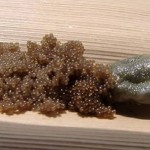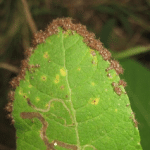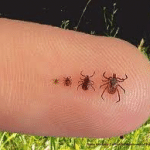Did you know that our cold winter temperatures here in New Jersey do NOT kill off the deer tick population? Many of them manage to survive over the winter and come back in the spring hungry and ready to start feeding. The females start laying eggs almost immediately to quickly rebuild the tick population.
In this article, we will discuss where ticks spend the winter, at what temperatures they are likely to emerge, and more.
 How Winter Temperatures Impact Ticks
How Winter Temperatures Impact Ticks
Deer ticks will be harder to find once temperatures reach 35 degrees Fahrenheit or below. They can be killed by extremely low temperatures, usually around negative 2 degrees Fahrenheit.
Deer ticks, in particular, are well-adapted to survive the winter. Scientists have discovered that ticks are able to decrease the water in their cells, which can alter the cellular freezing point, allowing them to survive in cold temperatures.
It is estimated that around 20% of the deer tick population does not survive through the winter, though that number may be decreasing as winters become warmer.
However, the rapid change in temperature may be the factor that kills ticks. If the weather warms above freezing and deer ticks emerge, they could be caught by a rapid onset of colder weather, which impacts them before they return to their warm pile of leaves.

Where Deer Ticks Spend the Winter
Most deer ticks will hide in piles of weeds, leaves, pine needles, or other tree or plant litter. When snow falls, it provides a protective layer and insulates the ticks in the leaf pile.
Other species of ticks will burrow into the ground during the winter, hide in cracks in crevices, or go into a state of hibernation or dormancy. One species of tick, known as the winter tick, will latch on to a warm-blooded host (usually moose or deer) to survive the winter. The winter ticks spend their entire lives with a single host.
When Ticks Emerge
As daytime temperatures warm up in late winter and early spring, you can expect over-wintering adult and nymphal deer ticks to start emerging.
In fact, if the temperature remains above freezing for several days in a row, ticks can re-emerge at any time. Deer ticks are most active from March to mid-May and from mid-August to November.

Female deer ticks lay several thousand eggs each
As the adult black-legged deer ticks (Ixodes scapularis) emerge, the females will seek out a large blood meal to prepare them to lay nearly 3000 eggs in early spring. Deer ticks are opportunistic feeders – they’ll latch onto any passing warm-blooded “meal”, including you and your pets – so start checking for signs of tick bites in early spring.
Tick Larvae
Hatched larvae crawl upwards and congregate near the tips of leaves and tall grass blades waiting for a warm-blooded host to pass by. Your first instinct may be to freak out if you happen to brush into such a larval cluster, but don’t panic: larvae are not Lyme disease carriers as they have not yet had their first blood meal so have not had the opportunity to contract the Lyme bacteria.

Cluster of deer tick larvae
Larvae are tiny and can be difficult to spot, so take the time to check yourself carefully if you’ve been outside in areas where larvae may be.
Nymph Deer Ticks
Half of all nymph deer ticks, on the other hand, are estimated to be infected with the Lyme spirochete.
Because of their small size and difficulty in being detected, they are responsible for 90% of all Lyme disease cases. Still, it takes 24-48 hours for a tick to transmit enough of the Lyme bacteria to its host, so we recommend careful, daily inspection after spending time outdoors.
Early Season Tick Control

Deer tick stages from left: larva, nymph, adult male, adult female
The first spray of our Organic Tick Control program plays an important role in suppressing the tick population for the season. We get them early so the population doesn’t have a chance to start growing.
Learn more about our multi-visit Organic Tick Control programs here >>
And to protect yourself, check out our Tips to Minimize Your Risk for tick and mosquito-borne illness.
Contact us or give us a call at 908-309-6611 for a free estimate and to learn how our Organic Tick Control program can reduce ticks on your property without using harmful synthetic chemicals.
GET THE LATEST NEWS
Subscribe to the Organic Plant Care Newsletter and get timely and helpful tips and updates monthly.
There's no spam - we promise!





